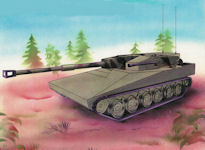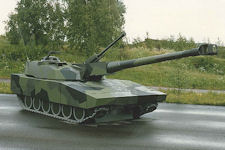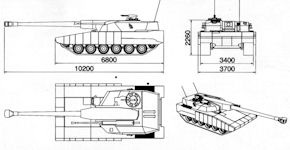Swedish tank Stridsvagn-2000
In the 1980s all the leading countries of the world were engaged in the development of so-called tanks of ultimate parameters. At that time, armed weapons were already in service (main battle tanks), but it was assumed that they should be replaced by armored vehicles with higher combat qualities.
Thus, in Sweden, the development of the Stridsvagn-2000 (Strv-2000) tank began in 1984. The main supplier of the studies on the Swedish concepts was HB Utveckling AB - the jointly owned company between AB Bofors and AB Hägglunds & Söner. In parallel, the door was also kept open for direct purchase or licensing of a foreign option. A large number of different concepts on a new Swedish tank were developed at HB Development.
One feature was the location of the engine with a power of 1,475 hp. and transmissions in the front of the hull. Initially, the tank was planned to be armed with a 120-mm smooth-bore gun Rh-120, but it was assumed that the “tank of the limiting parameters” should have adequate firepower.
Therefore in the mid-1980s it was decided to switch to a new caliber - 140 mm. This caliber, compared to 12 cm cannon, gave a doubled orifice energy and 25-50% higher impact power. The gun would have ammunition in 38 charges, and its loading would be automated. But the amount of ammo later went down to 29 shells. The problem was that the 14 cm ammunition was significantly larger and heavier than its predecessor; In order to stay within reasonable weights and volumes, significantly fewer shots could be carried.
In addition to the 140-mm guns, it was planned to mount a coaxial "Akan" 40mm gun to deal with softer threats. It was also planned to equip the tank with two 7.62 machine guns to increase the combat capabilities of the tank.
The minimum required protection was protection against APFSDS and ATGM's from the front, ATGM protection 180 degrees around the vehicle and that it could sustain autocannon fire to the rear 180 degrees. The swedish put highest priority on protection around the development of the vehicle. With the addition of modern composites in tanks, Sweden started a study to design its own composite material to use for the Strv 2000. Inspired by the American DU Composite, Sweden had found a Ceramic Composite that would function equally good.
Protection of the Swedish military vehicle was planned to provide in several ways: by reducing the visibility of the tank in the infrared, optical and radar ranges, as well as through combined armor based on metal and ceramics. Such armor could provide protection not only from 125-mm projectiles, but also from artillery shells. The crew of the tank was to consist of 3 people.
With the end of the Cold War, the Strv 2000 project was ready to be finalized. A Mmckup was made, and the Swedish military had to come to a final decision on whether creating a completely new vehicle or import cheap tanks from another country that has extensively developed their tank. The unanimous view that the Swedish army's next tank would be foreign meant the end of the project Stridsvagn 2000. Decisions on this were taken formally in 1991 and were clarified in the defense decision the following year.
The decision was unanimous that importing Leopard 2 tanks and keeping them modern was the cheapest and easiest alternative as it was no longer deemed necessary to develop their own tank. Due to the high cost and complexity of the project, the development of Stridsvagn-2000 was limited only to research and the creation of layouts.
|
NEWSLETTER
|
| Join the GlobalSecurity.org mailing list |
|
|
|





